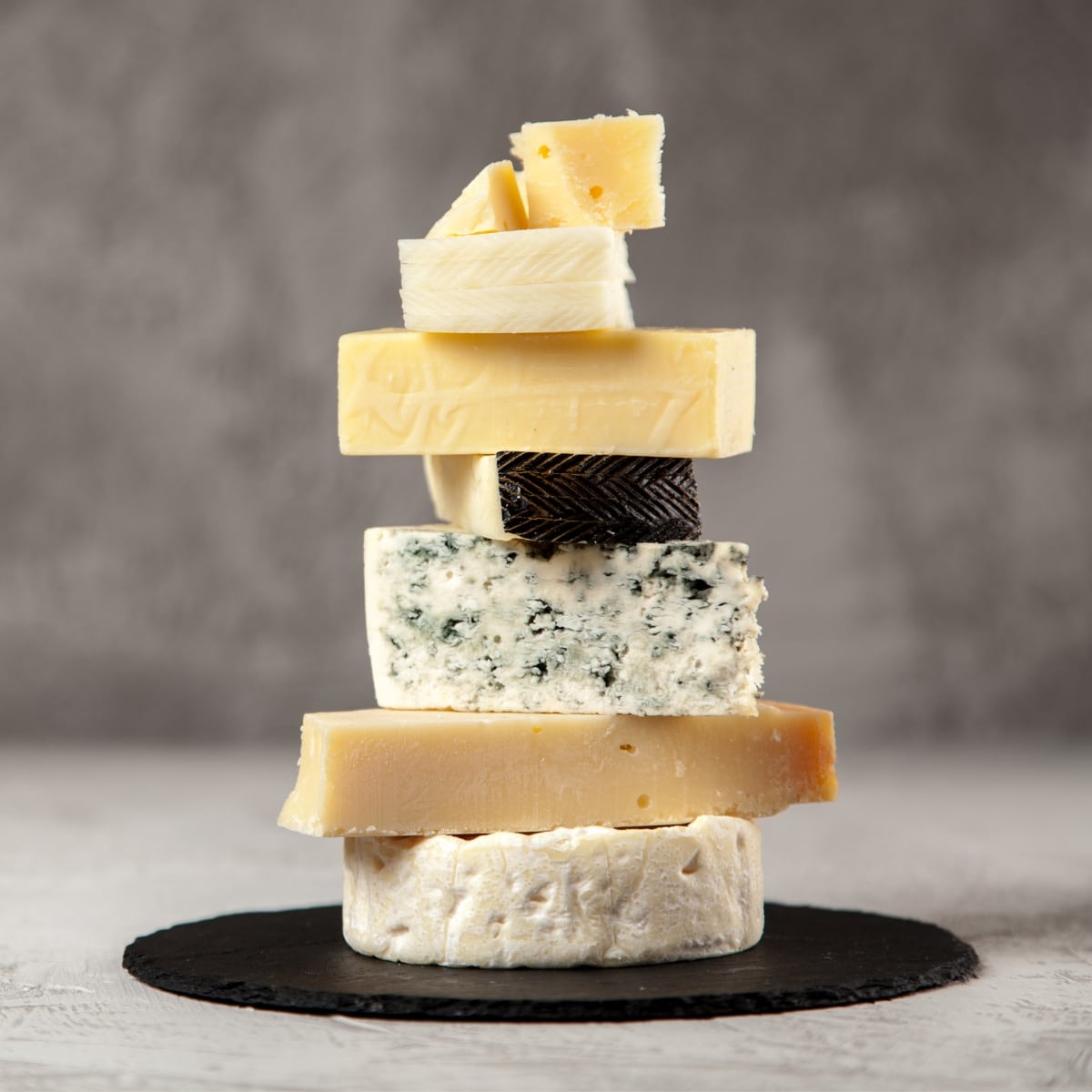Yes, you can freeze cheese, but it’s important to note that freezing can change its texture. Hard cheeses like cheddar or mozzarella freeze better than soft ones.
Thawed cheese might have a slightly altered texture. It’s more suitable for cooking or grating rather than for serving on a cheese platter.

Let’s take a deeper dive into what types of cheese you can freeze. I’ll also give you instructions on how to do it properly.
Can You Freeze Cheese?
You can freeze cheese, but not all cheeses should be frozen. Some cheese varieties freeze beautifully. Others, not so much.
While technically, all cheeses will freeze, some of them aren’t very good when they thaw out again. The freezing and thawing processes fundamentally change them.
And when you thaw them out, their texture is nowhere near what it should be. Some cheeses get crumbly after being frozen. Others get hard and lose their elasticity.
That’s why it’s so important to know which types of cheese you should and should not freeze.

What Kind of Cheese Can You Freeze?
Typically, the best cheese varieties for freezing are hard cheeses. These include Parmesan, Monterey and Pepper Jack, Gouda, and cheddar.
Hard cheeses retain less moisture than softer cheeses. Therefore, freezing them doesn’t affect their texture as badly as soft cheeses.
Still, even hard cheeses will undergo texture changes after being frozen. So, it’s best to only use frozen (or thawed) cheeses in recipes. Don’t eat them by themselves.
Soft cheeses, like brie or Camembert, have too much fat and water to freeze properly. After thawing, their texture is so bad, it doesn’t even hold up well in recipes.
You can also freeze cream cheese. However, avoid freezing cottage or ricotta cheeses.
Cheeses You Should Not Freeze
As mentioned, you should not freeze soft cheeses. Their moisture contents are too high, and they have too much fat. The exception to this rule is cream cheese, which freezes nicely.
Soft cheese varieties include but aren’t limited to the following:
- Brie
- Mozzarella
- Feta
- Gorgonzola
- Blue cheese
- Ricotta
- Camembert
- Munster
- Limburger
Typically, soft cheeses are those you find on cheese plates. They also appear on appetizer/antipasto boards and as cheese spreads.

How to Freeze Cheese
There are a few different ways to freeze cheese safely. No matter which method you use, there’s one thing you should do first.
Be sure to trim the cheese into a rectangular or cubed shape. Level off all the surfaces and cut the cheese into smaller pieces if necessary. Then, you have three options.
Freezer Bags
This isn’t the best option, but it’s the most convenient. Still, if you have parchment paper or a vacuum sealer, use those instead. If you don’t, a freezer bag will have to do. Place the cheese inside the bag and press out as much air as possible before sealing it.
The more contact the cheese has with oxygen, the more its taste and texture will degrade. So be sure to get out all the air you can before sealing the bag and freezing it.
Vacuum Sealer
The vacuum sealer is the opposite of freezer bags. It’s the best option for freezing cheese, but it’s not super convenient for many. Not everyone has a vacuum sealer.
If you have one (or can borrow one) it’s your best bet. With it, you can suck out all of the air and seal the bag tightly.
The cheese will remain fresher for longer if you remove all contact with oxygen. Its texture won’t be nearly as bad when thawed out again, either.
Parchment Paper & Aluminum Foil
Parchment paper is the happy medium between vacuum sealers and freezer bags. It doesn’t work as well as a vacuum sealer, but people are likelier to have it on hand.
Here are the steps for freezing your cheese this way:
- Wrap the cheese tightly in a layer of parchment paper.
- Then, wrap the cheese again in a layer of aluminum foil.
- Use a marker to add a date to the aluminum foil layer.
- Place the cheese in the freezer.
Try to use the cheese within a month of freezing for best results.

How Long Can You Freeze Cheese?
Using a vacuum sealer allows you to freeze cheese for the longest period. It should remain relatively fresh and undamaged for up to 2 months.
If you wrap the cheese in parchment paper and aluminum foil, it’ll last about a month. Cheese sealed in freezer bags will only last for 1 to 2 weeks.
Remember, these suggested times assume the cheese you froze is hard cheese. Even with a vacuum sealer, soft cheeses won’t last nearly as long.
Also, don’t refreeze cheese after it’s thawed.
Does Frozen Cheese Taste Different?
If you try to freeze soft cheeses, they’ll taste different after being frozen. Hard cheeses, however, don’t undergo many changes in the flavor department.
The harder the cheese, the less likely you’ll notice any flavor changes. (Assuming you remove it from the freezer in the time limits outlined above.)
With cheese, the texture is the biggest problem when freezing. Even hard cheeses contain some fat and moisture. Therefore, when thawed, their texture will be noticeably different.
Creamy cheeses can become blocky and crumbly. Cheese spreads (like cream cheese) can become grainy and less smooth.
For these reasons, it’s best to use frozen cheeses in cooked recipes only.
Trying to consume them raw or by themselves isn’t a good idea. They don’t even work well in something like a grilled cheese sandwich. (Recipes where cheese is the star of the show.)
However, they’re perfect for tossing into a skillet or casserole dish as part of a larger recipe.

How to Thaw Cheese
For some recipes, you can use frozen cheese without thawing it. Though mozzarella isn’t one of the best cheeses to freeze, it’s an excellent example.
If you’re making a homemade pizza, you can add frozen mozzarella before putting it in the oven. It’ll thaw and melt just like fresh or thawed mozzarella.
Parmesan is another example. You can add it frozen to whatever dish you’re making. Simply let it cook along with the other ingredients.
Most of the time, thawing the cheese before using it is the way to go. The process for doing that is simple. Transfer it from the freezer to the refrigerator.
Keep it wrapped in parchment paper or its air-tight container. Give it about 12 hours (or overnight) to thaw before using it. If you have the time, this method is always best.
Giving the cheese time to thaw also gives it time to “breathe.” The moisture in the cheese melts. When it does, it returns some of its original elasticity and softness.
Using the cheese while it’s still frozen should always be a last resort. And, though I’ve said this already, remember never to refreeze the cheese once it’s thawed.











